
Isfahan or Esfahan/Espahan is a major city in the Central District of Isfahan County, Isfahan province, Iran. It is the capital of the province, the county, and the district. It is located 440 kilometres south of Tehran. The city has a population of approximately 2,220,000, making it the third-most populous city in Iran, after Tehran and Mashhad, and the second-largest metropolitan area.
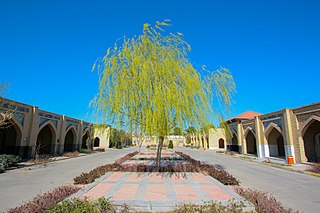
Behesht-e Zahra is the largest cemetery in Iran. Located in the southern part of metropolitan Tehran, it is connected to the city by Tehran Metro Line 1.

An Iranian architect is traditionally called a mi'mar.

Ibn Babawayh cemetery, also spelled as Ebn-e Babviyeh, Ebn-e Babooyeh, is located in Iran in the town of Rey.
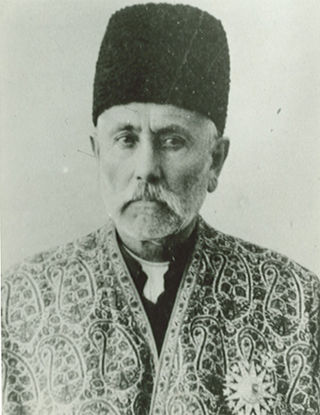
Najaf-Qoli Khan Bakhtiari also known as Saad al-Dowleh and Samsam al-Saltane (1846–1930), was a Persian Prime Minister and a leader of the Iranian Constitutional Revolution. He was elected Prime Minister for two terms, first from 3 May 1909 to 16 July 1909 and again from 23 December 1912 to 17 January 1913, when he resigned from the office. He was a representative of Parliament of Iran from Tehran in the 4th Parliament. He was the older brother of Ali-Qoli Khan Bakhtiari, better known as Sardar Assad, Bibi Maryam Bakhtiari and Khosrou Khan, Sardar Zafar Bakhtiari. He died in 1930 in Isfahan.

Shahshahan Mausoleum is a historical mausoleum in the Ebn-e Sina district of Isfahan, Iran. The mausoleum contains the tomb of Shah Ala al-Din Muhammad, or known simply as Shah Alaeddin. It was built in the 15th century, and it is the 368th national monument of Iran.

Sheikh Jafar ibn Hussein ibn Ali Shooshtari was a prominent Shia scholar from the city of Shooshtar.
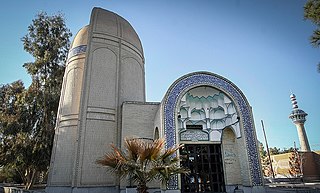
Takht-e Foulad, also known as Lissanul Arz is a historical cemetery in Isfahan, Iran. It is a large funerary complex that includes several historic mausoleums, mosques, tekyehs, sub-cemeteries and standalone graves.
The Ali ebn-e Sahl mausoleum is a historical mausoleum in Isfahan, Iran. The mystic Abolhassan Ali ebn-e Sahl Azhar Esfahani lived in the era of the Al-Mu'tadid, the Abbasid caliph. He had a khanqah and a school in the north of the Toghchi cemetery. He died in 894 in Isfahan and was buried in his khanqah.
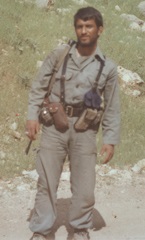
Hossein Qajeyi was an Iranian military commander in the Iranian Revolutionary Guard Corps and prominent military figure in the Iran-Iraq War. He was the founder of the IRGC's 27th Mohammad Rasulullah Division and served as the division's first commander during the war.

Grand Ayatollah Mulla Muhammad Ashrafi was a leading Iranian Shia Marja' in Mazandaran; Iran from roughly 1839 to his death in 1898. His Father Mulla Muhammad Mehdi was one of the Ulama of Behshahr. He was his first teacher and thought him primary cleric subjects and tried to nurture him with shia knowledge and Ahl Al-Bait friendship and love.

The Iranian city of Isfahan is divided into 15 districts.

Mullah Mohammad Jafar Sabzevari was one of the Iranian scholars and clerics of the 12th century AH, the Imam of Friday Prayer of the Shah Mosque in Isfahan and the author of several books and treatises including "Nowruznameh" and "Ma'ad" which was compiled at the request of Shah Sultan Hussein Safavid.
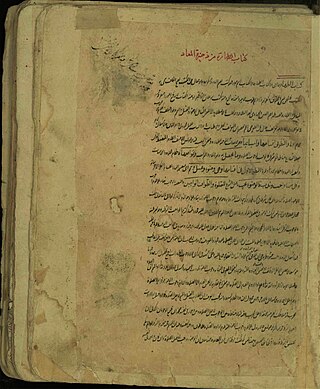
Mohammad Bagher Sabzevari known as Mohaghegh Sabzevari was an Iranian Faqih and Shiite scholar from the 11th century AH, Shaykh al-Islām and the Imam of Friday Prayer of Isfahan.

Mohammad Hossein Esheni or Mohammad Hossein Esheni Qudejani was an Iranian Shia cleric and experienced Faqih.
Noureddin Esheni Qudejani or Noureddin Qudejani Esheni was an Iranian Shia cleric, famous preacher and orator of Isfahan, Faqih, lawyer and professor of Isfahan Seminary. He was the famous Salah al jama'ah imam of the Seyyed Mosque of Isfahan. He was one of the modernist clerics and the first cleric to study law and become a lawyer.

Golzar Shahada of Qom or Golzar Shahada Ali Ibn Jafar is a cemetery in Qom, Iran. This cemetery is the burial place of famous and historical people, also burial place of the martyrs of the Iran-Iraq war. This cemetery is the largest cemetery in Qom province. This cemetery is known as the second national cemetery of Iran with 3,000 martyrs belonging to the Iran-Iraq war and more than a thousand international martyrs. In this cemetery, prominent and important people are buried, including the martyrs related to the events of the Iranian revolution and the victims related to the Mena incident. Also, apart from Qomi and Iranian martyrs, there are also Iraqi martyrs who refused to fight in the Iraqi front, so they fought alongside the Iranian fighters against the Ba'ath regime and are buried in this cemetery.
![<span class="mw-page-title-main">Imamzadeh Ali ibn Jafar</span> An Iranian holy place which a respected person is buried there ([[Imamzadeh]])](https://upload.wikimedia.org/wikipedia/commons/thumb/d/d5/.%D8%A7%D9%85%D8%A7%D9%85%D8%B2%D8%A7%D8%AF%D9%87_%D8%B9%D9%84%DB%8C_%D8%A8%D9%86_%D8%AC%D8%B9%D9%81%D8%B1_%D9%82%D9%85_02.jpg/320px-.%D8%A7%D9%85%D8%A7%D9%85%D8%B2%D8%A7%D8%AF%D9%87_%D8%B9%D9%84%DB%8C_%D8%A8%D9%86_%D8%AC%D8%B9%D9%81%D8%B1_%D9%82%D9%85_02.jpg)
The Imamzadeh Ali ibn Jafar is a religious monument dating back to the 8th century A.H. It is located in Qom, Iran, Enghelab St., next to Golzar Shohada of Qom. This monument was registered as one of Iran's national heritage works on December 7, 1935, with registration number 240. Additionally, a court named after Imamzadeh Ali ibn Jafar has been reported in Semnan, known as Imamzadeh Ali ibn Jafar Semnan.


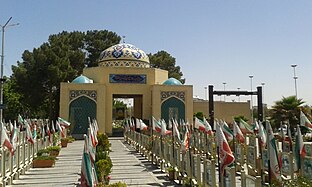





















![<span class="mw-page-title-main">Imamzadeh Ali ibn Jafar</span> An Iranian holy place which a respected person is buried there ([[Imamzadeh]])](https://upload.wikimedia.org/wikipedia/commons/thumb/d/d5/.%D8%A7%D9%85%D8%A7%D9%85%D8%B2%D8%A7%D8%AF%D9%87_%D8%B9%D9%84%DB%8C_%D8%A8%D9%86_%D8%AC%D8%B9%D9%81%D8%B1_%D9%82%D9%85_02.jpg/320px-.%D8%A7%D9%85%D8%A7%D9%85%D8%B2%D8%A7%D8%AF%D9%87_%D8%B9%D9%84%DB%8C_%D8%A8%D9%86_%D8%AC%D8%B9%D9%81%D8%B1_%D9%82%D9%85_02.jpg)